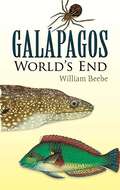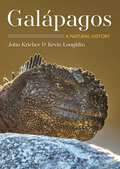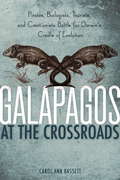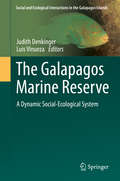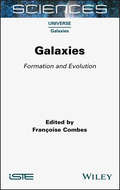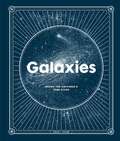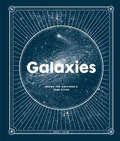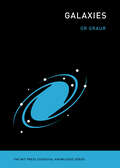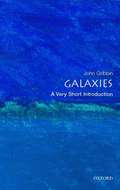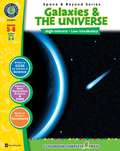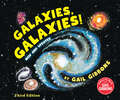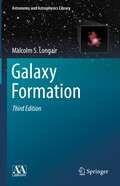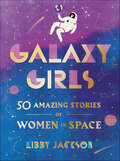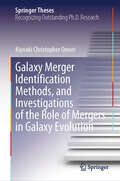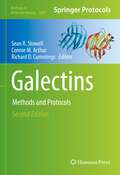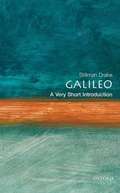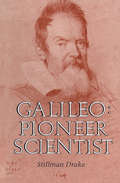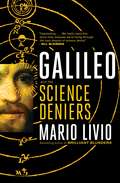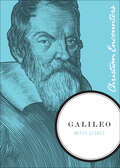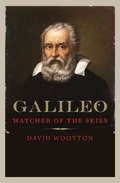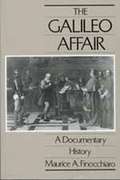- Table View
- List View
Galapagos: World's End
by William Beebe"Galápagos is a glorious book. It is high romance, exact science, fascinating history, wild adventure."--NationThe Galápagos Islands are famed for their remarkable wildlife, including land and marine iguanas, land tortoises, four-eyed fish, and flightless cormorants and albatross. In 1835, Charles Darwin observed variations among the islands' species that inspired him to formulate the theory of natural selection. Eighty-eight years later, in 1923, a scientific expedition sponsored by the New York Zoological Society followed in Darwin's wake. Led by renowned biologist and explorer William Beebe, the scientists visited the the islands to study and obtain specimens of indigenous plants and animals. This is Beebe's personal account of that fascinating expedition.Combining rare literary skill with careful research, Beebe produced an exceptionally readable volume, replete with youthful enthusiasm, a romantic's awe before the mysteries of nature, and a scientist's passion for accurate description. He recounts the expedition's enormously productive results, including specimens of 60 species previously unknown to science, and an unparalleled accumulation of data that stimulated many scientific papers and new avenues of naturalistic inquiry. Beebe's account is enhanced with more than 100 splendid illustrations, selected from hundreds of paintings, drawings, and photographs by expedition members. A classic of popular science, it is scientifically rigorous as well as exciting and accessible.
Galápagos: A Natural History Second Edition
by John C. Kricher Kevin LoughlinA richly illustrated nature tour of Galápagos—now expanded, thoroughly updated, and with more than 650 color photographsGalápagos is a comprehensive, up-to-date, and profusely illustrated natural history of this spectacular archipelago. Offering much more information than identification guides, the book provides detailed accounts and more than 650 color photographs of the islands’ habitats, marine life, reptiles, birds, mammals, and plants, making the book a virtual nature tour of Galápagos.Galápagos experts John Kricher and Kevin Loughlin have thoroughly revised the original text, bringing all the taxonomy up to date and adding a wealth of new information. Individual chapters cover geology, ecology, human history, Darwin’s finches and how Darwin came to his theory of natural selection from his visit to the islands, Galápagos tortoises, marine and land iguanas, mammals, seabirds, landbirds, marine life, and conservation challenges and initiatives. The concluding chapter covers each of the individual islands, including landing sites, unique plant and animal species, and points of interest, and serves as a wonderful guide for visitors as they move from island to island or plan a trip to Galápagos.With its combination of rich text and splendid photos, Galápagos is essential reading for the ecotraveler and nature enthusiast alike.Now with more than 650 color photographs, showing habitats, geology, marine life, and all the commonly encountered reptiles, birds, mammals, and plantsFeatures a detailed island-by-island guide, including landing sites and what visitors can expectEssential reading for the ecotraveler and nature enthusiast
Galapagos at the Crossroads: Pirates, Biologists, Tourists, and Creationists Battle for Darwin's Cradle of Evolution
by Carol Ann BassettFor millions, the Galapagos Islands represent nature at its most unspoiled, an inviolate place famed for its rare flora and fauna. But soon today's 30,000 human residents could surpass 50,000. Add invasive species, floods of tourists, and unresolved conflicts between Ecuadorian laws and local concerns, and it's easy to see why the Galapagos were recently added to UNESCO's World Heritage in Danger list. Each chapter in this provocative, perceptive book focuses on a specific person or group with a stake in the Galapagos' natural resources; from tour companies whose activities are often illegal and not always green, to creationist guides who lead tours with no mention of evolution, from fishermen up in arms over lobster quotas, to modern-day pirates who poach endangered marine species. Bassett presents a perspective as readable as it is sensible. Told with wit, passion, and grace, the Galapagos story serves as a miniature model of Earth itself, a perfect example of how an environment can be destroyed, and what is being done to preserve these islands before it's too late.
The Galapagos Marine Reserve
by Judith Denkinger Luis VinuezaThis book focuses on how marine systems respond to natural and anthropogenic perturbations (ENSO, overfishing, pollution, tourism, invasive species, climate-change). Authors explain in their chapters how this information can guide management and conservation actions to help orient and better manage, restore and sustain the ecosystems services and goods that are derived from the ocean, while considering the complex issues that affect the delicate nature of the Islands. This book will contribute to a new understanding of the Galapagos Islands and marine ecosystems.
Galaxies: Formation and Evolution
by Françoise CombesGalaxies are vast ensembles of stars, gas and dust, embedded in dark matter halos. They are the basic building blocks of the Universe, gathered in groups, clusters and super-clusters. They exist in many forms, either as spheroids or disks. Classifications, such as the Hubble sequence (based on mass concentration and gas fraction) and the colormagnitude diagram (which separates a blue cloud from a red sequence) help to understand their formation and evolution. Galaxies spend a large part of their lives in the blue cloud, forming stars as spiral or dwarf galaxies. Then, via a mechanism that is still unclear, they stop forming stars and quietly end in the red sequence, as spheroids. This transformation may be due to galaxy interactions, or because of the feedback of active nuclei, through the energy released by their central super-massive black holes. These mechanisms could explain the history of cosmic star formation, the rate of which was far greater in the first half of the Universe's life. Galaxies delves into all of these surrounding subjects in six chapters written by dedicated, specialist astronomers and researchers in the field, from their numerical simulations to their evolutions.
Galaxies: Inside the Universe's Star Cities
by David EicherHave you ever wanted to explore the Milky Way? Are you curious about how black holes form (and what really happens if you get stuck in one)?Do you want to learn how to read the night sky from your back garden?Tour the most dazzling, fascinating, and unusual galaxies in the universe with the editor in chief of Astronomy as your personal guide, featuring jaw-dropping illustrations and full-colour photography from the magazine's archives, much of it never before published. The cheapest one-way ticket to space money can buy, Galaxies will answer all of your questions about the mysteries of our cosmos.
Galaxies: Inside the Universe's Star Cities (Astronomy Library #Vol. 4)
by David J. EicherTour the incredible scope of the cosmos as we know it with the editor in chief of Astronomy, featuring jaw-dropping illustrations and full-color photography from the magazine&’s archives, much of it never before published. &“The natural history of the galaxies is majestic and deserves its own David Attenborough. In David Eicher, it may have just found him.&”—Richard Dawkins Journey to the edges of our galaxy and beyond with one of the most widely recognized astronomy experts as your guide. Delve into the history of stargazing and space observation, learn how black holes power galaxies, and understand the classification of the different galaxy types. This illuminating book—with artful illustrations and never-before-seen space photography—will open your mind to the wonders of the universe that await.
Galaxies (The MIT Press Essential Knowledge series)
by Or GraurAn eminently readable overview of the history and physics of galaxies.In Galaxies, Or Graur offers a brief and fascinating overview of the history, physics, and astrophysical uses of galaxies. Starting with the history of the last two thousand years of galaxy studies, Graur discusses the types of galaxies we observe and the physics that drive them; the myths and physical structure of the Milky Way; how galaxies were used to discover and study the mysterious phenomena of dark matter and dark energy; and how scientists think galaxies formed shortly after the Big Bang and evolved to their present forms. Tracing galaxy studies back thousands of years ago to their beginnings, Graur describes their origin in Ptolemy’s book Almagest, which was written in the first century CE. Almagest catalogued hundreds of stars and a few hazy cloud-like objects, one of which was the Andromeda galaxy. The reader will also encounter in this book well-known figures such as William Herschel, who, along with his sister Caroline (the first professional female astronomer), discovered hundreds of galaxies and lay the foundations for modern galaxy studies, as well as lesser-known astronomers, including tenth-century Persian astronomer Abd al-Rahman al-Sufi, twentieth-century American astronomer Vesto Melvin Slipher, and others. Galaxies concludes by showing readers how they can get involved in galaxy studies themselves and do their part to fight the light pollution that today obscures the Milky Way and all but the brightest of stars.Providing a brief but broad overview of galaxies for the nonspecialist, Galaxies shows just how modern science is done and what the future holds for this specific field of astronomy.
Galaxies: A Very Short Introduction
by John GribbinIn this fascinating Very Short Introduction, popular science writer John Gribben tells the story of our growing understanding of galaxies, from the days before Galileo to our present-day observations of our many hundreds of millions of galactic neighbors. Not only are galaxies fascinating astronomical structures in themselves, but their study has revealed much of what we know today about the cosmos, providing a window on the Big Bang and the origins of the Universe. Gribben looks at our own "Milky Way" Galaxy in detail, from the different kinds of stars that are born within it, to the origins of its magnificent spiral structure. Perhaps most interesting, Gribben describes the many exciting discoveries have been made about our own galaxy and about those beyond: how a supermassive black hole lurks at the center of every galaxy, how enormous forces are released when galaxies collide, how distant galaxies provide a window on the early Universe, and how the formation of young galaxies shed needed light on the mysteries of Cold Dark Matter.
Galaxies and the Universe
by Charlene HomerGet the big picture about galaxies and our universe. From the smallest particles of matter to the biggest star system, our universe is made up of all things that exist in space. Our resource takes you through the Milky Way Galaxy, Black Holes and Gravity, then on to Nebulae, Sources of Light and the Speed of Light, and finally to Quasars, the most distant objects in the universe.
Galaxies and the Universe (World Book's Solar System and Space Exploration Library)
by Dan BlunkIntroduction to Galaxies and the Universe, providing to primary and intermediate grade students, information on their features and exploration. Includes fun facts, glossary, resource list and index.
Galaxies, Galaxies! (New & Updated Edition)
by Gail GibbonsPlanet Earth is in the Milky Way Galaxy, the cloudy band of light that stretches clear across the night sky. How many galaxies are there in the universe? For years astronomers thought that the Milky Way was the universe. Now we know that there are billions of them. Gail Gibbons takes the reader on a journey light-years away.
Galaxies, Galaxies! (Third Edition)
by Gail GibbonsLearn about the newest discoveries in the Milky Way and beyond in this updated edition from nonfiction master Gail Gibbons.Planet Earth is in the Milky Way Galaxy, the cloudy band of light that stretches clear across the night sky. How many galaxies are there in the universe? For years astronomers thought that the Milky Way was the universe. Now we know that there are billions of them. Gail Gibbons takes the reader on a journey light-years away.This updated edition vetted by an expert introduces young readers to our own galaxy the Milky Way and beyond. Learn how ancient people invented the telescope and began studying the Milky Way to the modern technology astronomers use to study other galaxies.Gail Gibbon&’s easy-to-read text and clearly labeled illustrations welcomes young readers to learn how telescopes work, about the different types of galaxies, how many galaxies we know of today, and more.
Galaxies in the Universe: An Introduction
by Linda S. Sparke John S. Gallagher IIIGalaxies are the places where gas turns into luminous stars, powered by nuclear reactions that also produce most of the chemical elements. But the gas and stars are only the tip of an iceberg: a galaxy consists mostly of dark matter, which we know only by the pull of its gravity. The ages, chemical composition and motions of the stars we see today, and the shapes that they make up, tell us about each galaxy's past life. This book presents the astrophysics of galaxies since their beginnings in the early Universe. This second Edition is extensively illustrated with the most recent observational data. It includes new sections on galaxy clusters, gamma ray bursts and supermassive black holes. Chapters on the large-scale structure and early galaxies have been thoroughly revised to take into account recent discoveries such as dark energy. The authors begin with the basic properties of stars and explore the Milky Way before working out towards nearby galaxies and the distant Universe, where galaxies can be seen in their early stages. They then discuss the structures of galaxies and how galaxies have developed, and relate this to the evolution of the Universe. The book also examines ways of observing galaxies across the electromagnetic spectrum, and explores dark matter through its gravitational pull on matter and light. This book is self-contained, including the necessary astronomical background, and homework problems with hints. It is ideal for advanced undergraduate students in astronomy and astrophysics. Book jacket.
Galaxy Formation (Astronomy and Astrophysics Library)
by Malcolm S. LongairDelineating the huge strides taken in cosmology in the past ten years, this much-anticipated second edition of Malcolm Longair's highly appreciated textbook has been extensively and thoroughly updated. It tells the story of modern astrophysical cosmology from the perspective of one of its most important and fundamental problems – how did the galaxies come about? Longair uses this approach to introduce the whole of what may be called "classical cosmology". What’s more, he describes how the study of the origin of galaxies and larger-scale structures in the Universe has provided us with direct information about the physics of the very early Universe.
Galaxy Formation and Evolution
by Houjun Mo Frank Van Den Bosch Simon WhiteThe rapidly expanding field of galaxy formation lies at the interface between astronomy, particle physics, and cosmology. Covering diverse topics from these disciplines, all of which are needed to understand how galaxies form and evolve, this book is ideal for researchers entering the field. Individual chapters explore the evolution of the Universe as a whole and its particle and radiation content; linear and nonlinear growth of cosmic structure; processes affecting the gaseous and dark matter components of galaxies and their stellar populations; the formation of spiral and elliptical galaxies; central supermassive black holes and the activity associated with them; galaxy interactions; and the intergalactic medium. Emphasizing both observational and theoretical aspects, this book provides a coherent introduction for astronomers, cosmologists, and astroparticle physicists to the broad range of science underlying the formation and evolution of galaxies.
Galaxy Girls: 50 Amazing Stories of Women in Space
by Libby JacksonFilled with beautiful full-color illustrations, a groundbreaking compendium honoring the amazing true stories of fifty inspirational women who helped fuel some of the greatest achievements in space exploration from the nineteenth century to today—including Hidden Figure’s Mary Jackson and Katherine Johnson as well as former NASA Chief Astronaut Peggy Whitson, the record-holding American biochemistry researcher who has spent the most cumulative time in space.When Neil Armstrong stepped off the ladder of the lunar module, Eagle, he famously spoke of “one small step for man.” But Armstrong would not have reached the moon without the help of women. Today, females across the earth and above it—astronauts and mathematicians, engineers and physicists, test pilots and aerospace psychophysiologists—are pushing the boundaries of human knowledge, helping us to understand the universe and our place in it. Galaxy Girls celebrates more than four dozen extraordinary women from around the globe whose contributions have been fundamental to the story of humankind’s quest to reach the stars.From Ada Lovelace in the nineteenth century to the “colored computers” behind the Apollo missions, from the astronauts breaking records on the International Space Station to the scientific pioneers blazing the way to Mars, Galaxy Girls goes boldly where few books have gone before, celebrating this band of heroic sisters and their remarkable and often little known scientific achievements. Written by Libby Jackson, a leading British expert in human space flight, and illustrated with striking artwork from the students of London College of Communication, Galaxy Girls will fire the imaginations of trailblazers of all ages.
Galaxy Merger Identification Methods, and Investigations of the Role of Mergers in Galaxy Evolution (Springer Theses)
by Kiyoaki Christopher OmoriThis book offers new findings on the impact of galaxy mergers on galaxy evolution and related processes. Galaxies are astronomical objects composed of stars, gas, and dark matter. The main pathway for galaxy evolution in the currently accepted model for structure growth is through interactions and mergers, or the process in which multiple galaxies interact, collide, and end up as one larger galaxy. Galaxy interactions and mergers are also considered to drive various processes pertaining to galaxy evolution, such as star formation, active galactic nuclei (AGN) activity, and chemical evolution. As such, not only are merging galaxy systems important to understand galaxy structure growth in a cosmological context, they are also unique laboratories to study evolutionary processes taking place in galaxies. However, despite their importance, the relative role of galaxy mergers on galaxy evolution is still heavily contested. One reason for this is difficulty in identifying merger galaxies in observational data. Many different methods have been adopted for merger galaxy identification, but none of them are perfect. Moreover, the use of differing selection methods can result in widely different samples, which can alter statistical results. As such, a novel, robust method for merger identification is required to deepen our understanding of galaxy mergers. In this book, we introduce new methods to identify galaxy mergers from observational data. The first method combines the use of visual identification—both of optical and kinematic images—with spectroscopic pair identification. The second is machine learning based, using a training method called fine-tuning, an application of transfer learning. A pre-trained model on galaxy images is further fine-tuned using a sample of synthetic galaxy images, to make a classifier for merger identification. Using samples identified by our methods, the author conducts three studies: the impact of mergers on galaxy chemical evolution, the effect of galaxy local environment on merging activity, and the connection between mergers and AGN activity. This book is mainly intended for astrophysicists, particularly those studying galaxies, however is open for all to read.
Galectins: Methods and Protocols (Methods in Molecular Biology #2442)
by Sean R. Stowell Connie M. Arthur Richard D. CummingsThis second edition is dedicated to new and updated methodological approaches designed to study galectin function. Chapters examine salient features of galectin functions. Written in the successful Methods in Molecular Biology series format, chapters include introductions to their respective topics, lists of the necessary materials and reagents, step-by-step, readily reproducible protocols, and notes on troubleshooting and avoiding known pitfalls. Authoritative and cutting-edge, Galectins: Methods and Protocols, Second Eidtion aims to be a useful practical guide to researches to help further their study in this field.
Galileo: A Very Short Introduction
by Stillman DrakeIn a startling reinterpretation of Galileo's trial, Stillman Drake advances the hypothesis that Galileo's prosecution and condemnation by the Inquisition was caused not by his defiance of the Church but by the hostility of contemporary philosophers. Galileo's own beautifully lucid arguments are used in this volume to show how his scientific method was utterly divorced from the Aristotelian approach to physics; it was based on a search not for causes but for laws. Galileo's methods had an overwhelming significance for the development of modern physics, and they led to a final parting of the ways between science and philosophy. Now, in this extraordinary and concise introduction, Drake provides a stimulating view of Galileo's life and works, providing a fresh perspective on Galileo's methodology and his final incrimination.
Galileo: Pioneer Scientist
by Stillman DrakeSince publication of Stillman Drake?s landmark volume, Galileo at Work: His Scientific Biography, new and exciting information has come to light about this towering figure in the history of Western science. Drawing largely from Galileo?s manuscript working papers, Drake now adds a wealth of detail to the story. Among the findings he presents in this volume are the steps that led to discovery of the pendulum law and the law of fall, by which Galileo opened the road to modern physics; Galileo?s path to the new astronomy of Copernicus, closely linked to his first essays in physics; his subsequent misgivings and final reassurances provided by the telescope. Drake focuses on Galileo?s pioneering work in physics, previously unknown, and shows that time has not diminished its value. He also considers some of the factors that played a part in the development of physics, its classical Greek beginnings, the medieval interlude, the contribution of some of Galileo?s contemporaries, and the resistance of others to his new science of motion. We see in a new light the relation of that science to modern dynamics, created by Newton half a century later. Galileo is better known as an astronomer than as a modern physicist. Drake sheds new light here too as he explores Galileo?s pioneer invention of satellite astronomy, his sighting of Neptune two and one-half centuries before that planet was identified, and his proposal of a cosmogony based on speeds of freely falling bodies. With this book Drake confirms Galileo as the first recognizably modern scientist, in both his methods and results.
Galileo: And the Science Deniers
by Mario LivioA fresh interpretation of the life of Galileo Galilei, one of history&’s greatest and most fascinating scientists, that sheds new light on his discoveries and how he was challenged by science deniers. &“We really need this story now, because we&’re living through the next chapter of science denial&” (Bill McKibben).Galileo&’s story may be more relevant today than ever before. At present, we face enormous crises—such as the minimization of the dangers of climate change—because the science behind these threats is erroneously questioned or ignored. Galileo encountered this problem 400 years ago. His discoveries, based on careful observations and ingenious experiments, contradicted conventional wisdom and the teachings of the church at the time. Consequently, in a blatant assault on freedom of thought, his books were forbidden by church authorities. Astrophysicist and bestselling author Mario Livio draws on his own scientific expertise to provide captivating insights into how Galileo reached his bold new conclusions about the cosmos and the laws of nature. A freethinker who followed the evidence wherever it led him, Galileo was one of the most significant figures behind the scientific revolution. He believed that every educated person should know science as well as literature, and insisted on reaching the widest audience possible, publishing his books in Italian rather than Latin. Galileo was put on trial with his life in the balance for refusing to renounce his scientific convictions. He remains a hero and inspiration to scientists and all of those who respect science—which, as Livio reminds us in this gripping book, remains threatened even today.
Galileo (Christian Encounters)
by Mitch StokesWe learn about life through the lives of others. Their experiences, their trials, their adventures become our schools, our chapels, our playgrounds. Christian Encounters, a series of biographies from Thomas Nelson Publishers, highlights important lives from all ages and areas of the Church through prose as accessible and concise as it is personal and engaging. Some are familiar faces. Others are unexpected guests. Whether the person is Galileo, William F. Buckley, John Bunyan, or Isaac Newton, we are now living in the world that they created and understand both it and ourselves better in the light of their lives. Their relationships, struggles, prayers, and desires uniquely illuminate our shared experience.HERO OR HERETIC? GENIUS OR BLASPHEMER?It's no mystery how profound a role Galileo played in the Scientific Revolution. Less explored is the Italian innovator's sincere, guiding faith in God. In this exhaustively researched biography that reads like a page-turning novel, Mitch Stokes draws on his expertise in philosophy, logic, math, and science to attune modern ears with Galileo's controversial genius.Emerging from the same Florentine milieu that produced Dante, da Vinci, Machiavelli, Michelangelo, Amerigo Vespuci, Galileo questioned with a persistence that spurred his world toward an unabating era of discovery. Stokes confronts the myth that Galileo's stance on heliocentricity stood astride a church vs. science divide and explores his calculations for the dimensions of Dante's hell, his understanding of motion, and his invention of the pendulum clock.To read this volume is to journey through Galileo's remarkable life: from his inquisitive childhood to his dying days, when, although blind and decrepit, he soldiered on, dictating mathematical thoughts and mentoring young proteges.
Galileo: Watcher of the Skies
by David Wootton&“Demonstrates an awesome command of the vast Galileo literature . . . [Wootton] excels in boldly speculating about Galileo&’s motives&” (The New York Times Book Review). Tackling Galileo as astronomer, engineer, and author, David Wootton places him at the center of Renaissance culture. He traces Galileo through his early rebellious years; the beginnings of his scientific career constructing a &“new physics&”; his move to Florence seeking money, status, and greater freedom to attack intellectual orthodoxies; his trial for heresy and narrow escape from torture; and his house arrest and physical (though not intellectual) decline. Wootton also reveals much that is new—from Galileo&’s premature Copernicanism to a previously unrecognized illegitimate daughter—and, controversially, rejects the long-established belief that Galileo was a good Catholic. Absolutely central to Galileo&’s significance—and to science more broadly—is the telescope, the potential of which Galileo was the first to grasp. Wootton makes clear that it totally revolutionized and galvanized scientific endeavor to discover new and previously unimagined facts. Drawing extensively on Galileo&’s voluminous letters, many of which were self-censored and sly, this is an original, arresting, and highly readable biography of a difficult, remarkable Renaissance genius. Selected as a Choice Outstanding Academic Title in the Astronautics and Astronomy Category &“Fascinating reading . . . With this highly adventurous portrayal of Galileo&’s inner world, Wootton assures himself a high rank among the most radical recent Galileo interpreters . . . Undoubtedly Wootton makes an important contribution to Galileo scholarship.&” —America magazine &“Wootton&’s biography . . . is engagingly written and offers fresh insights into Galileo&’s intellectual development.&” —Standpoint magazine
The Galileo Affair: A Documentary History
by Maurice A. FinocchiaroThis book provides a documentary history of the series of developments which began in 1613 and culminated in 1633 with the trial and condemnation of Galileo.
